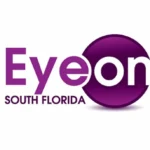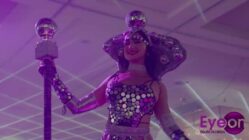Chicago’s mural culture is known across the states, and the city never fails to involve local artists in large projects, like the recently opened Color Factory. Well, if you haven’t noticed, there have been some incredible mural revelations, one of the being the window paintings at Pinstripes (435 E Illinois St, Chicago, IL 60611), titled “Chicago Looks Good On You.”
These large-scale portraits of fictional individuals literally wear Chicago icons such as the Buckingham Fountain, the Centennial Wheel at Navy Pier and Cloud Gate (the Bean), providing a fun and engaging way to learn about Chicago’s landmarks, while prompting the community to rethink about the relationship between an ordinary Chicagoan and the city’s culture. Today, we are fortunate enough to bring Chicago-based artist Paul Brourman, the creator behind “Chicago Looks Good On You” for an exclusive interview on the thoughts and process behind this new project.
Q (UrbanMatter): Welcome! So, how you’re feeling about the big unveiling. Still feeling the excitement? Tell us how it’s been!
A (Paul Brourman): Very excited. It’s been quite a week. It was incredible and was almost two years in the making. Between the development to presenting to the team to getting the approval and actually taking it up… originally, it was only going to be a one-window opportunity. And when I came back with the idea of using all the windows, they loved the idea so it became a much larger undertaking. I was thrilled.
Q: How exciting! Then, let’s start from the beginning — when did you come up with this idea? Was there a moment that made you want to create this project?
A: This was really in the context of the pandemic and all of the challenges Chicago was facing at the time. In late 2020, one of the marketing directors at Pinstripes saw a portrait of RBG I posted in memory of her passing. He then said it would be very cool if we could do something to celebrate Chicago during the times we’re in, because the idea was to remind people all the positive experiences they can have in Chicago.
I internalized that and took a long time to reflect upon my personal connections to Chicago and then developed this concept around the landmarks around the city and the role they played during that difficult time in providing a source of stability and kind of a reminder that as much as things might be changing around us at that given time, the landmarks remained the same and were still around us, giving us something to hang on to.
Q: Why not tell us a little more about your personal connection to Chicago, then? You’re clearly a local artist with a strong tie to the local scene, but give us more of your personal stories: how did you reach where you are today as an artist?
A: When I first moved to Chicago in 1988, there happened to be a show going on at the Art Institute featuring over 188 Monet’s oil paintings and I remember till this day. At that time, I was still an acrylic painter but always wanted to take on oil painting and pursue portrait painting. The only reason I hadn’t back then was because when I was 11, my grandmother got upset when I did a portrait of her in pencil and said “you made me look too overweight!” And that was the end of that.
I was inspired by the Monet show and decided to pursue [my passion for oil portraits]. I signed up for Sunday classes for painting, anatomy, and portrait work, and continued every Sunday for seven years during my [full-time] work in the advertising space. It’s become quite a passion for me.
Q: So how would you describe being a local artist in Chicago’s diverse and welcoming art scene? How would you say the impact the Chicago community has had on your career?
A: I love being part of the Chicago art community. I lived in Bucktown for 20 years. And that was where I was really pushed forward and found many inspirations from all the shows in Bucktown and Wicker Park area, as well as galleries downtown. All the art in Chicago is always a great source to pull energy from. So for me art was always the sideline pursuit, but it was still serious. Therefore, Chicago not only inspired me to pursue my art studies, but the culture itself and just being a part of that community has moved me forward so much.
For ten years, I was on the Public Trust Land Board and really gained a deeper understanding on what we really had in each neighborhood and the cultural diversity of those neighborhoods and how 606 cuts across the entire span… For me, that connection and experience all laddered up to this particular series which really represent Chicago and the vast range of people here and their unique part in the scene.
Q: Perfect! You basically told us your artist statement, good job! Now, we know mural is such a vital piece in Chicago’s culture. As an artist, what are your feelings about our mural culture and what it does to the community but also for those coming from other places?
A: I think they’re stunning. And the range of styles, expressiveness, and messaging that come through are so powerful. I made trips around city just touring the murals in different pockets. It’s truly a remarkable treasure Chicago has.
Q: Now, is there anything else you want to tell us about Chicago Looks Good On You?
Although this particular project is not physically painted, it is an installation about creating an impact with scale and to make a statement about the idea. So with the materials we used achieved an articulate replica of the texture of the original oil paintings after several months of work. The designer must ensure all details of the original come through in a high-resolution print, and then mold it around the window framing and Pinstripe’s entire structure at 16 feet high.
I was thrilled when I saw the result. The team at Pinstripes, the image group that worked with us are just phenomenal. This was really the first time my art was in a public context. As the installation became fully realized before the unveiling night, and already engaging with the passers-by… It was really exciting.
Q: Were there any hiccup moments?
A: Really, it was all about patience. With the pandemic putting dents on everyone’s plans, the ability to just keep our heads up and nose down and believe it’s gonna happen through these barriers was a big part of this project becoming real. I think, at any given point, the Pinstripes team and myself have all thought this was just too many challenges to work with. But we were driven to make this happen and everyone had that true excitement of making this real.
In our opinion, it was something the city needed. We felt like this will let us shine a light on all the positives that Chicago still offers every day since every one of these icons is an experience we can have whether it’s the first or the twentieth time.
Q: Now that you’ve seen your art in a public environment, do you think you will continue to pursue this direction?
A: I’ve had gallery shows and exhibits in Chicago and other states, but this [public art experience] was really eye-opening. For me, this type of exposure in the public — the involvement is a big part of it and I definitely see this as where my art is going. Now I want to see not only the original paintings but these extensive replicas of works in other states. “Chicago Looks Good On You” really got me excited for what’s next.
Q: At the unveiling, you used AR technologies and allowed visitors to actually wear these icons just like the portraits. So, what is your take on being a traditional artist in this era filled with VR, AR, and even AI painting?
A: I’m a big believer in using the tool at the time if they’re relevant, but not for the sake of using them. When I’m in my studio, I’m often doing hacks to create ways to use technology to capture textures and effects, and just experimenting. Technology is very much part of our toolkit today. If you look at Da Vinci and all the ways he’d use whatever technologies he had back then to apply to his artistic practice — I believe if he had digital tools he’d be going absolutely nuts!
So, I feel that technology should be used with some caution so it’s truly playing a role and is relevant to what you’re creating and your practice, instead of just for the sake of it.
Featured Image: Pinstripes
The post Chicago Looks Good On You: An Interview with Paul Brourman appeared first on UrbanMatter.






















